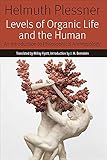Levels of organic life and the human : an introduction to philosophical anthropology / Helmuth Plessner ; introduction by J.M. Bernstein ; translated by Millay Hyatt.
Material type: TextLanguage: English Original language: German Publication details: New York : Fordham University Press, (c)2019.Edition: First editionDescription: 1 online resourceContent type:
TextLanguage: English Original language: German Publication details: New York : Fordham University Press, (c)2019.Edition: First editionDescription: 1 online resourceContent type: - text
- computer
- online resource
- 9780823284009
- 9780823284016
- QH331 .L484 2019
- COPYRIGHT NOT covered - Click this link to request copyright permission: https://lib.ciu.edu/copyright-request-form
| Item type | Current library | Collection | Call number | URL | Status | Date due | Barcode | |
|---|---|---|---|---|---|---|---|---|
 Online Book (LOGIN USING YOUR MY CIU LOGIN AND PASSWORD)
Online Book (LOGIN USING YOUR MY CIU LOGIN AND PASSWORD)
|
G. Allen Fleece Library ONLINE | Non-fiction | QH331 (Browse shelf(Opens below)) | Link to resource | Available | on1105557139 |
Includes bibliographies and index.
A modern classic, this powerful and sophisticated account of embodiment was first published in German in 1928 and now appears in English for the first time. With reference simultaneously to science, social theory, and philosophy, Plessner shows how life can be seen on its own terms to establish its own boundaries. Plessner's account of how the human establishes itself in relation to the nonhuman will invigorate a range of current conversations around the animal, posthumanism, the material turn, and the biology and sociology of cognition.
Intro; Half Title; Series Announcement Page; Title Page; Copyright; Contents; Foreword from the Helmuth Plessner Society; Translator's Preface and Acknowledgments; Preface to the First Edition (1928); Preface to the Second Edition (1965); Introduction; Epigraph; 1. Aim and Scope of the Study; The Development of Intuitionist Lebensphilosophie in Opposition to Experience; Lebensphilosophie and the Theory of the Humanities; Working Plan for the Foundation of a Philosophy of the Human; 2. The Cartesian Objection and the Nature of the Problem
Extension vs. Interiority and the Problem of AppearanceAppearance as Originating in Interiority; The Prior Givenness of Interiority and the Forward Displacement of Myself: The Proposition of Immanence; Extension as Outer World; Interiority as Inner World; The Proposition of Representation and the Element of Sensation; The Inaccessibility of Other I's according to the Principle of Sensualism; The Need for a Revision of the Cartesian Dichotomy in the Interest of a Science of Life; A Methodological Reformulation of the Opening Question; 3. The Thesis; The Question
The Dual Aspect in the Appearance of Ordinary Perceptual ThingsAgainst the Misinterpretation of This Analysis: A Closer Focus on the Subject Matter; The Dual Aspect of Living Perceptual Things: Köhler contra Driesch; How Is Dual Aspectivity Possible? The Nature of the Boundary; The Task of a Theory of the Essential Characteristics of the Organic; Definitions of Life; Nature and Object of a Theory of the Essential Characteristics of the Organic; 4. The Modes of Being of Vitality; Essential Characteristics Indicating Vitality; The Positionality of Living Being and Its Spacelikeness
Living Being as Process and Type the Dynamic Character of the Living Form; the Individuality of the Living Thing; Living Process as Development; The Curve of Development: Aging and Death; The Individual Living Thing as a System; The Self-Regulation of the Individual Living Thing and the Harmonious Equipotentiality of Its Parts; Individual Living Things as Organized: The Dual Meaning of Organs; The Temporality of Living Being; The Positional Union of Space and Time and the Natural Place; 5. The Organizational Modes of Living Being: Plants and Animals; The Circle of Life
Assimilation-DissimilationAdaptedness and Adaptation; Reproduction, Heredity, Selection; The Open Form of Organization of the Plant; The Closed Form of Organization of the Animal; 6. The Sphere of the Animal; The Positionality of the Closed Form: Centrality and Frontality; The Coordination of Stimulus and Response in the Case of an Inoperative Subject (Decentralized Type of Organization); The Coordination of Stimulus and Response by a Subject (Centralized Type of Organization); The Animal's Surrounding Field Organized into Complex Qualities and Things; Intelligence; Memory
COPYRIGHT NOT covered - Click this link to request copyright permission:
There are no comments on this title.
